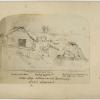Drawing of a Saami settlement on Lake Hammasjarvi
Commentary
Drawing in pencil by Arthur Evans of buildings at a Saami settlement beside Lake Hammasjarvi, showing a wooden hut (left), an open shed for drying fish and curing skins (centre), and a tent-like dwelling constructed of wood, hides, turf and thatch (right).
Artist: Arthur John Evans
Date of drawing: 30 August 1873
Continent: Europe
Geographical area: Northern Europe
Country: Finland
Region/Place: Lapland; Lake Hammasjarvi
Cultural group: European Saami
Format: Drawing (mounted on card)
Size: 74 x 121 mm; 173 x 245 mm (with mount)
Acquisition: Joan Evans. Donated August 1941
***
Primary documentation: ‘[p.588] Dr. JOAN EVANS, from the property of the late SIR ARTHUR EVANS, Youlbury, Boars Hill, Oxford. [List of items follows]’; ‘[p.590] 15 original pencil sketches of types & scenery, chiefly round ENARE, LAPPMARK, FINLAND. Made on journey in 1873. Mounted’: Pitt Rivers Museum accession records (Donations X, 1937–1941), pp.588, 590. Annotations on drawing: ‘Lapp house/ Hammasjärvi’ (written in pencil below drawing). Annotations on mount: ‘Shed for winter stores/ open shed for drying fish & curing skins./ Dwelling house - constructed of wood, hides, turf & thatch./ Fish Lapp settlement on Lake Hammasjayri/ Enare Lappmark’ (written on mount in brown ink).
Research notes: It has been established by Philip Grover that this drawing was made by Arthur Evans on 30 August 1873, when his travelling party was at Lake Hammasjarvi. Evans wrote in his journal of the voyage to Finnish Lapland: ‘As we neared the edge of the plateau, the lake of Hammasjärvi [Hammasjarvi], on whose banks the Lapp station we were bound for is situated - appeared below back by range after range of low mountains [...] we had to walk a long way through forests & swamps that line the edges of this large lake before we saw the Lapp huts & were finally ferried across the lake by a real Lapp & a little woman with a cap shaped like a Doge[’]s crown [...] The place consists of a tiny hut of the ordinary Finnish style, in which the younger woman lives - and a real Lapp wigwam which shelters the old crony it is square at bottom, & tapers to a round hole in the top which lets out the smoke, it is constructed partly of rough planks, partly of turf, partly of hide, & partly of thatch - In one of the sloping sides is a door of the rudest construction - inside there is some resemblance to the plan of a Lapp hut given by Scheffer two centuries ago - in the centre some rude stones, utterly unhewn, support the embers & above from a cross pole swings a hooked stick into the end of which is stuck the smallest piece of bent iron to hang pots over the fire. The floor is partitioned into berths by poles laid on it - & on the left hand as you enter reposes the old lady herself - In the centre is the hearth[.] All about are reindeer skins, dried fish’ (entry dated 30 August 1873): Ashmolean Museum of Art and Archaeology, Sir Arthur Evans Archive, B/2/1, Box 1, Notebook 2, pp.45, 46–48. For more information on Arthur Evans’ voyage to Finnish Lapland in 1873, see Joan Evans, Time and Chance: The Story of Arthur Evans and His Forebears (London, 1943), pp.172–176; Ann Brown, Before Knossos...: Arthur Evans’s Travels in the Balkans and Crete (Oxford, 1993), pp.14–16, 90; and Tony Lurcock, No Particular Hurry: British Travellers in Finland, 1830-1917 (London, 2013), pp.123–134, 250.

